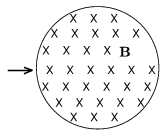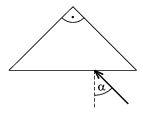Exercises and problems in Physics
October 2002
Please read The Conditions of the Problem Solving Competition.
 | Experimental problem |
M. 236. In the vinification process new wine is drawn from an upper barrel into a lower one through a rubber hose. Model this process with water. Examine the dependence of the water stream velocity on the level difference and on the length of the hose. (6 points)
 | Theoretical problemsIt is allowed to send solutions for any number of problems, but final scores of students of grades 9-12 are computed from the 5 best score in each month. Final scores of students of grades 1-8 are computed from the 3 best scores in each month. |
P. 3551. A crane driven by a toy DC electromotor is lifting a load of a mass of 200 g with 0.2 m/s velocity. What is the power of the crane's electromotor if 10% of the overall power goes against the friction? How much is the current drain of the 9 V electromotor if its efficiency is 80%? (4 points)
P. 3552. We try to measure the depth of a well on the basis of the delay of the splash of a stone we have dropped in. What is the error of the depth measurement if the error of our time measurement is p %? Neglect the aerodynamic drag and the time of sound propagation. When is it allowable to discard these data? (4 points)
P. 3553. Add forces of magnitude
F and kF including an \(\displaystyle \alpha\) angle with each other (k 1). At what
1). At what  angle
angle  ,
the angle of the resultant force and component kF, will be the
greatest? What is this angle? (5 points)
,
the angle of the resultant force and component kF, will be the
greatest? What is this angle? (5 points)

P. 3554. We release a solid ball and a cylinder from the top of a slope at the same time. Can they reach the bottom at the same time as well? (4 points)
P. 3555. We stand in front of a wall. Between us and the wall, at the height of our ears, there is a whistle blowing, at a frequency of 600 Hz. How fast must the whistle go towards the wall so that we can hear 3 beats a second? (4 points)
P. 3556. Inside the air-gap of a toroidal coil the magnetic field has a circular cross section and it can be considered homogeneous. If charged particles are coming in a radial direction perpendicular to the magnetic field lines, do the slower or the faster ones leave the magnetic field in a shorter time? (5 points)

P. 3557. A light beam is falling on the
hypotenuse of a rectangular symmetric glass prism from the air. Choose
the \(\displaystyle \alpha\)
angle of incidence so that total reflection will occur at both
opposing sides (n=1.5). a) Determine the angle
included by the beams incoming and leaving the
prism. b) What maximum value can we choose for angle  , so that
total reflections still occur? (5 points)
, so that
total reflections still occur? (5 points)

P. 3558. In an atomic reactor the slow, thermal neutrons cause atomic fissions with a greater probability than the faster ones. Therefore, the neutrons emerging from fission processes must be decelerated (moderated) with deuterium oxide or graphite. Determine what fraction of its energy does a neutron lose in a straight elastic collision with a 21H and a \(\displaystyle {}^{12}_{\phantom{1}6}\rm C\) atomic nucleus. (4 points)
P. 3559. Estimate what percentage of the area of Hungary has to be covered with modern (50% efficiency) solar panels if the current electric power need of the country (7 GW on average) is to be supplied by them. (5 points)
P. 3560. There is a 1 m long horizontal rod. One of its ends is fixed and on the other a body of a mass of 1 kg is hung causing a 1 cm deflection. Estimate the force F under which the same, vertically placed rod collapses. (Hint: the elastic energy of a bent rod is proportional to its length and inversely proportional to the square of the radius of curvature.) (6 points)

Send your solutions to the following address:
- KöMaL Szerkesztőség (KöMaL feladatok),
Budapest 112, Pf. 32. 1518, Hungary
